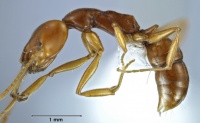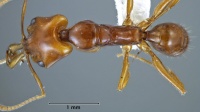Anochetus avius
| Anochetus avius | |
|---|---|

| |
| Scientific classification | |
| Kingdom: | Animalia |
| Phylum: | Arthropoda |
| Class: | Insecta |
| Order: | Hymenoptera |
| Family: | Formicidae |
| Subfamily: | Ponerinae |
| Tribe: | Ponerini |
| Genus: | Anochetus |
| Species: | A. avius |
| Binomial name | |
| Anochetus avius Shattuck & Slipinska, 2012 | |
The limited material currently available of this north-western Australian species was collected in traps in dry sclerophyll woodlands.
Identification
Entire body smooth and shining except for sculpturing between frontal carinae and scattered very weak striations on propodeal dorsum; eyes small (eye length < 0.25mm). This species is similar to Anochetus armstrongi in lacking essentially all significant sculpturing other than on the front of the head. It can be separated from A. armstrongi, and the otherwise similar Anochetus renatae, by its smaller eye size (eye length < 0.25mm vs. > 0.30mm) and shorter scapes (scape length < 1.00mm vs. > 1.05mm) and legs (mid-tibial length < 0.80mm vs. > 0.85mm, hind femur length < 1.10mm vs. > 1.18mm). Anochetus avius is also allopatric to both of these species, being the only one of these found in northern Western Australia.
Keys including this Species
Distribution
Latitudinal Distribution Pattern
Latitudinal Range: -14.56666667° to -14.85°.
| North Temperate |
North Subtropical |
Tropical | South Subtropical |
South Temperate |
- Source: AntMaps
Distribution based on Regional Taxon Lists
Australasian Region: Australia (type locality).
Distribution based on AntMaps
Distribution based on AntWeb specimens
Check data from AntWeb
Countries Occupied
| Number of countries occupied by this species based on AntWiki Regional Taxon Lists. In general, fewer countries occupied indicates a narrower range, while more countries indicates a more widespread species. |

|
Estimated Abundance
| Relative abundance based on number of AntMaps records per species (this species within the purple bar). Fewer records (to the left) indicates a less abundant/encountered species while more records (to the right) indicates more abundant/encountered species. |

|
Biology
Castes
Nomenclature
The following information is derived from Barry Bolton's Online Catalogue of the Ants of the World.
- avius. Anochetus avius Shattuck & Slipinska, 2012: 8, figs. 6, 7 (w.) AUSTRALIA (Western Australia).
- Type-material: holotype worker, 3 paratype workers.
- Type-locality: holotype Australia: Western Australia, Walsh Point, Admiralty Gulf, , 14°34’S, 125°51’E, 16.v.1983 (J. Balderson); paratypes: 1 worker with same data, 1 worker Western Australia, Carson Escarpment, Kimberley region, vi.1986 (J.D. Majer), 1 worker Western Australia, Lone Dingo, Mitchell Plateau, 9-19.v.1983 (I.D. Naumann & J.C. Cardale).
- Type-depository: ANIC.
- Distribution: Australia.
Type Material
- Holotype, worker, Walsh Point, Admiralty Gulf, Western Australia, Australia, 14°34′S 125°51′E / 14.567°S 125.85°E, 16 May 1983, J. Balderson, ANIC32-044213, Australian National Insect Collection.
- Paratype, 1 worker, Walsh Point, Admiralty Gulf, Western Australia, Australia, 14°34′S 125°51′E / 14.567°S 125.85°E, 16 May 1983, J. Balderson, ANIC32-059557, Australian National Insect Collection.
- Paratype, 1 worker, Carson Escarpment, Kimberley region, Western Australia, Australia, 14°51′S 126°49′E / 14.85°S 126.817°E, June 1986, J.D. Majer, ANIC32-015884, Australian National Insect Collection.
- Paratype, 1 worker, Lone Dingo, Mitchell Plateau, Western Australia, Australia, 14°35′S 126°45′E / 14.583°S 126.75°E, 9–19 May 1983, I.D. Naumann & J.C. Cardale, ANIC32-016070, Australian National Insect Collection.
Taxonomic Notes
This species is superficially similar to A. armstrongi and Brown (1978) considered specimens placed here as belonging to that taxon. However, as conceived by Shattuck & Slipinska (2012) this species is consistently smaller than A. armstrongi as defined here. Additionally, these two species show distinct geographic and ecological patterns with A. avius being restricted to extreme northern Western Australia and A. armstrongi occurring broadly across south-eastern Australia, the habitats in these regions showing numerous ecological differences with essentially no overlap. Given this it seems appropriate to consider these as two distinct taxa rather than simply forms of a single variable taxon.
Description
Worker description. Sculpturing on front of head extending slightly beyond eyes. Scapes not reaching posterolateral corners ('lobes') of head; erect hairs present but scattered. Mesosoma smooth and shining, sculpturing limited to weak rugae or striations near the metanotal groove and on propodeal dorsum. Propodeal angles rounded. Petiolar node robust with thick truncate apex, lacking sculpture. Erect hairs on hind tibiae absent except for a few near the spurs. Colour yellow-brown to brown, head and legs slightly lighter in colour.
Measurements. Worker (n = 4): CI 88–92; EI 19–20; EL 0.17–0.22; HL 1.04–1.23; HW 0.91–1.10; HFL 0.86–1.07; ML 1.30–1.60; MandL 0.54–0.66; MTL 0.62–0.75; PronI 58–61; PronW 0.55–0.66; SL 0.83–0.98; SI 88–91.
References
- Heterick, B.E. 2021. A guide to the ants of Western Australia. Part I: Systematics. Records of the Western Australian Museum, Supplement 86, 1-245 (doi:10.18195/issn.0313-122x.86.2021.001-245).
- Heterick, B.E. 2022. A guide to the ants of Western Australia. Part II: Distribution and biology. Records of the Western Australian Museum, supplement 86: 247-510 (doi:10.18195/issn.0313-122x.86.2022.247-510).
- Shattuck, S.O. & Slipinska, E. 2012. Revision of the Australian species of the ant genus Anochetus (Hymenoptera Formicidae). Zootaxa 3426, 1–28.
References based on Global Ant Biodiversity Informatics
- Shattuck S. O., and E. Slipinska. 2012. Revision of the Australian species of the ant genus Anochetus (Hymeoptera: Formicidae). Zootaxa 3426: 1-28.

